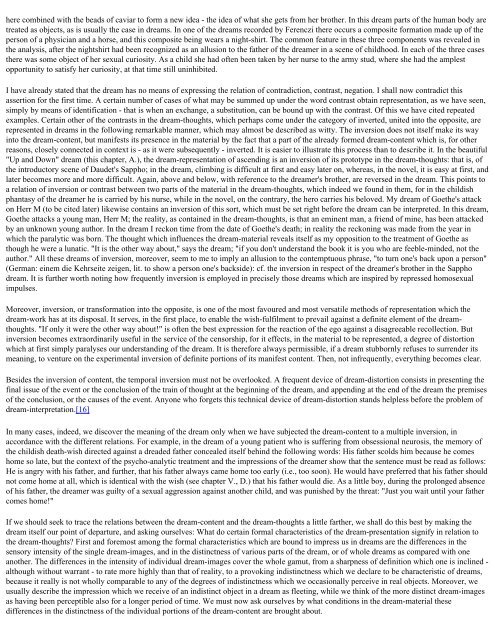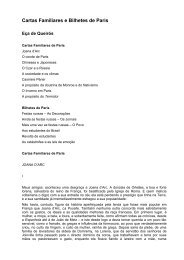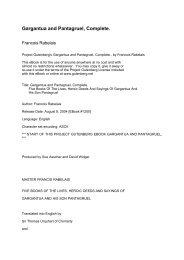The Interpretation of Dreams Sigmund Freud (1900)
The Interpretation of Dreams Sigmund Freud (1900)
The Interpretation of Dreams Sigmund Freud (1900)
Create successful ePaper yourself
Turn your PDF publications into a flip-book with our unique Google optimized e-Paper software.
here combined with the beads <strong>of</strong> caviar to form a new idea - the idea <strong>of</strong> what she gets from her brother. In this dream parts <strong>of</strong> the human body are<br />
treated as objects, as is usually the case in dreams. In one <strong>of</strong> the dreams recorded by Ferenczi there occurs a composite formation made up <strong>of</strong> the<br />
person <strong>of</strong> a physician and a horse, and this composite being wears a night-shirt. <strong>The</strong> common feature in these three components was revealed in<br />
the analysis, after the nightshirt had been recognized as an allusion to the father <strong>of</strong> the dreamer in a scene <strong>of</strong> childhood. In each <strong>of</strong> the three cases<br />
there was some object <strong>of</strong> her sexual curiosity. As a child she had <strong>of</strong>ten been taken by her nurse to the army stud, where she had the amplest<br />
opportunity to satisfy her curiosity, at that time still uninhibited.<br />
I have already stated that the dream has no means <strong>of</strong> expressing the relation <strong>of</strong> contradiction, contrast, negation. I shall now contradict this<br />
assertion for the first time. A certain number <strong>of</strong> cases <strong>of</strong> what may be summed up under the word contrast obtain representation, as we have seen,<br />
simply by means <strong>of</strong> identification - that is when an exchange, a substitution, can be bound up with the contrast. Of this we have cited repeated<br />
examples. Certain other <strong>of</strong> the contrasts in the dream-thoughts, which perhaps come under the category <strong>of</strong> inverted, united into the opposite, are<br />
represented in dreams in the following remarkable manner, which may almost be described as witty. <strong>The</strong> inversion does not itself make its way<br />
into the dream-content, but manifests its presence in the material by the fact that a part <strong>of</strong> the already formed dream-content which is, for other<br />
reasons, closely connected in context is - as it were subsequently - inverted. It is easier to illustrate this process than to describe it. In the beautiful<br />
"Up and Down" dream (this chapter, A.), the dream-representation <strong>of</strong> ascending is an inversion <strong>of</strong> its prototype in the dream-thoughts: that is, <strong>of</strong><br />
the introductory scene <strong>of</strong> Daudet's Sappho; in the dream, climbing is difficult at first and easy later on, whereas, in the novel, it is easy at first, and<br />
later becomes more and more difficult. Again, above and below, with reference to the dreamer's brother, are reversed in the dream. This points to<br />
a relation <strong>of</strong> inversion or contrast between two parts <strong>of</strong> the material in the dream-thoughts, which indeed we found in them, for in the childish<br />
phantasy <strong>of</strong> the dreamer he is carried by his nurse, while in the novel, on the contrary, the hero carries his beloved. My dream <strong>of</strong> Goethe's attack<br />
on Herr M (to be cited later) likewise contains an inversion <strong>of</strong> this sort, which must be set right before the dream can be interpreted. In this dream,<br />
Goethe attacks a young man, Herr M; the reality, as contained in the dream-thoughts, is that an eminent man, a friend <strong>of</strong> mine, has been attacked<br />
by an unknown young author. In the dream I reckon time from the date <strong>of</strong> Goethe's death; in reality the reckoning was made from the year in<br />
which the paralytic was born. <strong>The</strong> thought which influences the dream-material reveals itself as my opposition to the treatment <strong>of</strong> Goethe as<br />
though he were a lunatic. "It is the other way about," says the dream; "if you don't understand the book it is you who are feeble-minded, not the<br />
author." All these dreams <strong>of</strong> inversion, moreover, seem to me to imply an allusion to the contemptuous phrase, "to turn one's back upon a person"<br />
(German: einem die Kehrseite zeigen, lit. to show a person one's backside): cf. the inversion in respect <strong>of</strong> the dreamer's brother in the Sappho<br />
dream. It is further worth noting how frequently inversion is employed in precisely those dreams which are inspired by repressed homosexual<br />
impulses.<br />
Moreover, inversion, or transformation into the opposite, is one <strong>of</strong> the most favoured and most versatile methods <strong>of</strong> representation which the<br />
dream-work has at its disposal. It serves, in the first place, to enable the wish-fulfilment to prevail against a definite element <strong>of</strong> the dreamthoughts.<br />
"If only it were the other way about!" is <strong>of</strong>ten the best expression for the reaction <strong>of</strong> the ego against a disagreeable recollection. But<br />
inversion becomes extraordinarily useful in the service <strong>of</strong> the censorship, for it effects, in the material to be represented, a degree <strong>of</strong> distortion<br />
which at first simply paralyses our understanding <strong>of</strong> the dream. It is therefore always permissible, if a dream stubbornly refuses to surrender its<br />
meaning, to venture on the experimental inversion <strong>of</strong> definite portions <strong>of</strong> its manifest content. <strong>The</strong>n, not infrequently, everything becomes clear.<br />
Besides the inversion <strong>of</strong> content, the temporal inversion must not be overlooked. A frequent device <strong>of</strong> dream-distortion consists in presenting the<br />
final issue <strong>of</strong> the event or the conclusion <strong>of</strong> the train <strong>of</strong> thought at the beginning <strong>of</strong> the dream, and appending at the end <strong>of</strong> the dream the premises<br />
<strong>of</strong> the conclusion, or the causes <strong>of</strong> the event. Anyone who forgets this technical device <strong>of</strong> dream-distortion stands helpless before the problem <strong>of</strong><br />
dream-interpretation.[16]<br />
In many cases, indeed, we discover the meaning <strong>of</strong> the dream only when we have subjected the dream-content to a multiple inversion, in<br />
accordance with the different relations. For example, in the dream <strong>of</strong> a young patient who is suffering from obsessional neurosis, the memory <strong>of</strong><br />
the childish death-wish directed against a dreaded father concealed itself behind the following words: His father scolds him because he comes<br />
home so late, but the context <strong>of</strong> the psycho-analytic treatment and the impressions <strong>of</strong> the dreamer show that the sentence must be read as follows:<br />
He is angry with his father, and further, that his father always came home too early (i.e., too soon). He would have preferred that his father should<br />
not come home at all, which is identical with the wish (see chapter V., D.) that his father would die. As a little boy, during the prolonged absence<br />
<strong>of</strong> his father, the dreamer was guilty <strong>of</strong> a sexual aggression against another child, and was punished by the threat: "Just you wait until your father<br />
comes home!"<br />
If we should seek to trace the relations between the dream-content and the dream-thoughts a little farther, we shall do this best by making the<br />
dream itself our point <strong>of</strong> departure, and asking ourselves: What do certain formal characteristics <strong>of</strong> the dream-presentation signify in relation to<br />
the dream-thoughts? First and foremost among the formal characteristics which are bound to impress us in dreams are the differences in the<br />
sensory intensity <strong>of</strong> the single dream-images, and in the distinctness <strong>of</strong> various parts <strong>of</strong> the dream, or <strong>of</strong> whole dreams as compared with one<br />
another. <strong>The</strong> differences in the intensity <strong>of</strong> individual dream-images cover the whole gamut, from a sharpness <strong>of</strong> definition which one is inclined -<br />
although without warrant - to rate more highly than that <strong>of</strong> reality, to a provoking indistinctness which we declare to be characteristic <strong>of</strong> dreams,<br />
because it really is not wholly comparable to any <strong>of</strong> the degrees <strong>of</strong> indistinctness which we occasionally perceive in real objects. Moreover, we<br />
usually describe the impression which we receive <strong>of</strong> an indistinct object in a dream as fleeting, while we think <strong>of</strong> the more distinct dream-images<br />
as having been perceptible also for a longer period <strong>of</strong> time. We must now ask ourselves by what conditions in the dream-material these<br />
differences in the distinctness <strong>of</strong> the individual portions <strong>of</strong> the dream-content are brought about.









